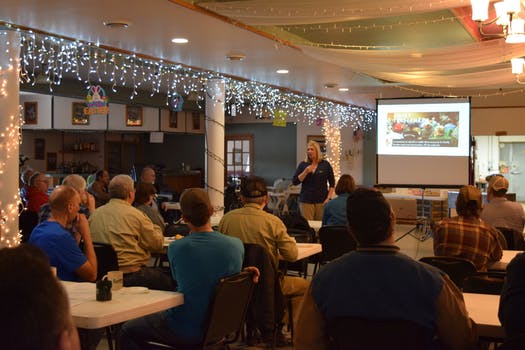
GREENWALD, Minn. – David Van Drehle, a dairy farmer 35 miles west of St. Cloud, took $11,000 out of savings to balance the books in 2018, and he doesn’t see how the business will get any better.
“I made a nice living on 50 cows until three years ago. It’s getting worse every year,” Van Drehle said. “We’ve got a son graduating from high school this year. He wants to farm. She tells him not to.”
He jerked his thumb toward his wife, Luann, sitting next to him.
“What for?” she said.
Milk prices are in a four-year slump, the big dairies keep getting bigger and the small ones keep going out of business. More than 1,100 Minnesota dairy farmers have quit in the past six years.
Dairy farmers have reached a breaking point, taking to social media to voice their desperation and now hoping for government intervention in a marketplace that’s pushing them out.
The Van Drehles and about 80 other dairy farmers gathered at the Greenwald Pub on Tuesday, grabbed a cinnamon roll and a cup of coffee, and sat down to discuss ways to save dairies winking out of existence.
“We are going through a massive, massive structural change that I don’t think is for the better,” Dick Levins, a former professor of economics at the University of Minnesota, told them.
The trend is the same across the country. Since 2000, more than 64,000 dairies with fewer than 200 cows have closed. Over that same period, the number of mega-dairies — those with 1,000 or more cows — has more than doubled.
It costs small dairies more to produce milk. A farm with fewer than 200 cows produces a hundredweight of milk (about 112 pounds, or roughly a day-and-a-half’s production from a single cow) for about $16.28, including the costs of feed, taxes, insurance and hired labor, the U.S. Department of Agriculture estimates. A dairy with more than 1,000 cows produces a hundredweight of milk for about $14.61.
The price of milk has been just under $16 per hundredweight for most of the past three years. That’s left small dairies operating at losses while larger ones remained profitable.
And in today’s dairy industry, 1,000 cows is no longer unthinkably large. One Minnesota company, Riverview LLP outside of Morris, is building dairies with 9,000 cows each and daily milks more cows than all the dairy farmers in states such as Illinois or Virginia. Riverview is still expanding.
The growth of industrial-scale dairies rankled many of the farmers assembled in Greenwald last week. At least one called for a halt to their construction.
“They’re greedy,” said Paul Martin, who owns a 40-cow dairy farm near Long Prairie. “How much money do you need? How much do you need to own? The whole world?”
Losing small dairies — the Agriculture Department projects there will be only 18,000 dairies left in the United States by 2036 — is bad for rural communities, Levins said as heads nodded around the room. It would pose food security risks since all the milk would be produced in a few places, and the businesses who serve small dairies — veterinarians, feed and equipment dealers — would suffer since large dairies often handle those services in-house.
Levins outlined a proposed Family Dairy Farm Relief Act on National Farmers Organization letterhead that would make emergency federal payments to farmers based on their cost of production. Small dairies would get more money per hundredweight of milk produced and extremely large dairies would get none. The program, aimed at addressing what it calls an “operating cost imbalance,” would cost about $2.8 billion per year.
The legislation hasn’t been written, let alone introduced.
“Timeliness is critical right now,” warned Keith Landwehr, a dairy farmer near Melrose, from the back of the room. “People are going out of business. When they go out of business, they’re out.”
Two longer-term proposals to limit the market advantages of large dairies emerged at the meeting.
A National Farmers proposal would mandate higher prices for milk produced by smaller dairies — $4 more per hundredweight for the first 1 million pounds of monthly milk production per farm. A dairy would need more than 800 cows to produce 1 million pounds of milk per month, so all smaller farms would benefit.
A Wisconsin Farmers Union proposal aims to achieve the same goal by imposing a “market access fee” for dairies that want to expand, pooling the money from the fees and then disbursing it to farmers who don’t expand.
Neither proposal is close to legislative reality.
The position at Land O’Lakes, the Arden Hills-based farmer-owned cooperative, is that there’s room for all dairy sizes in today’s market. Pete Kappelman, a former dairyman and vice president of member services for the cooperative, said some smaller dairies are making money and some larger dairies are losing money.
“It’s not easy to generalize on how people work to decide their cost of production,” Kappelman said. “There have been political efforts for many years to try to establish a national quota, or whatever you call it, and quite frankly we got tired of waiting for that.”
Land O’Lakes established its own “base program” in recent years to try to limit the milk supply. The cooperative still accepts all the milk produced by any of its 1,850 dairy farmers but sets a base amount of production with each dairy and can penalize anything over that through price.
The goal is to maintain a higher price for all Land O’Lakes dairy farmers. Land O’Lakes posted a $59 million profit in its dairy foods segment in 2018, paid about $35 million of that out to farmers and plowed the rest of it back into the business.
“We want to build the business into an ongoing proposition for not just this generation’s farmers but the next generation’s farmers,” Kappelman said.
Despite the strength of the Land O’Lakes brands and its base program, dairy farmers in Minnesota are still going out of business, and the farmers in the room in Greenwald last week said they weren’t optimistic that any of the proposed federal government interventions will happen.
“I’ve been to so many dairy meetings,” Van Drehle said. “Nothing ever happened.”
Indeed, the Greenwald meeting was the seventh of nine “Dairy Together” gatherings organized by the Wisconsin Farmers Union “to rebuild a viable dairy economy.”
Holly Tuman, who helps run a farm with 100 dairy cows near Melrose, said she didn’t think the dairy industry could agree on what to do.
“At this point, dairy farmers probably would agree on something, but not the co-ops,” she said. “We’re kind of over a barrel.”

























